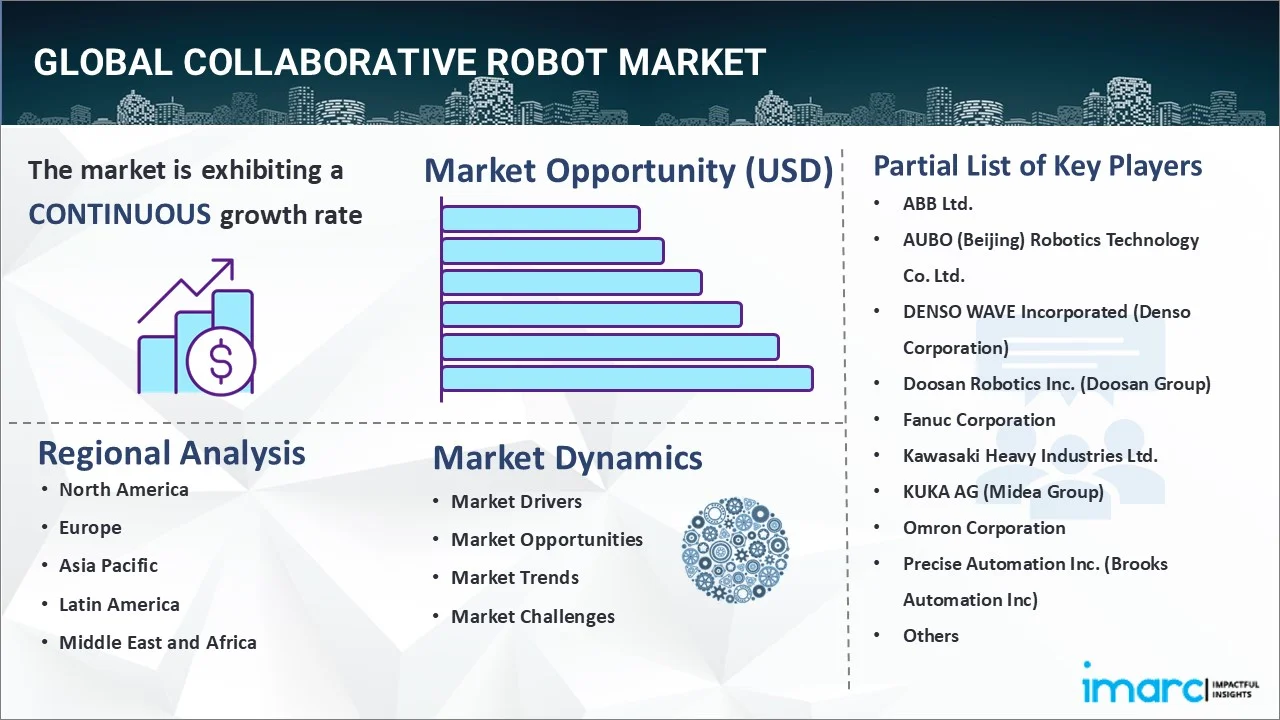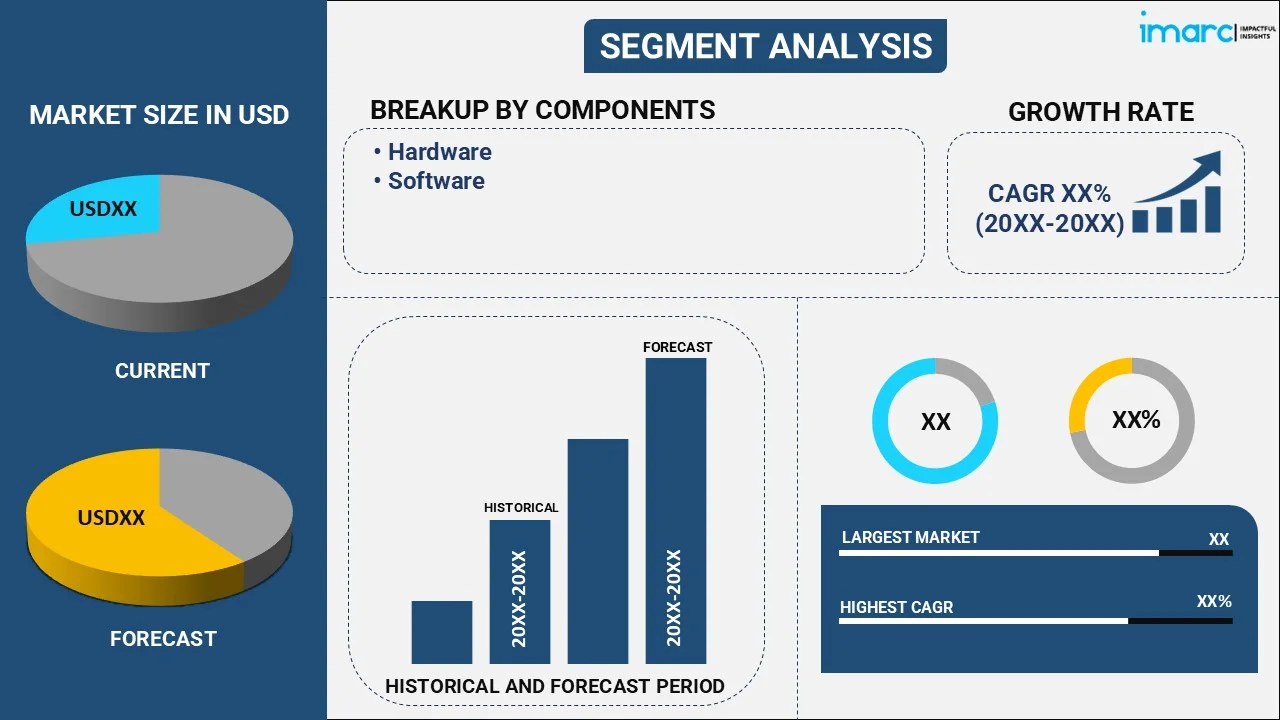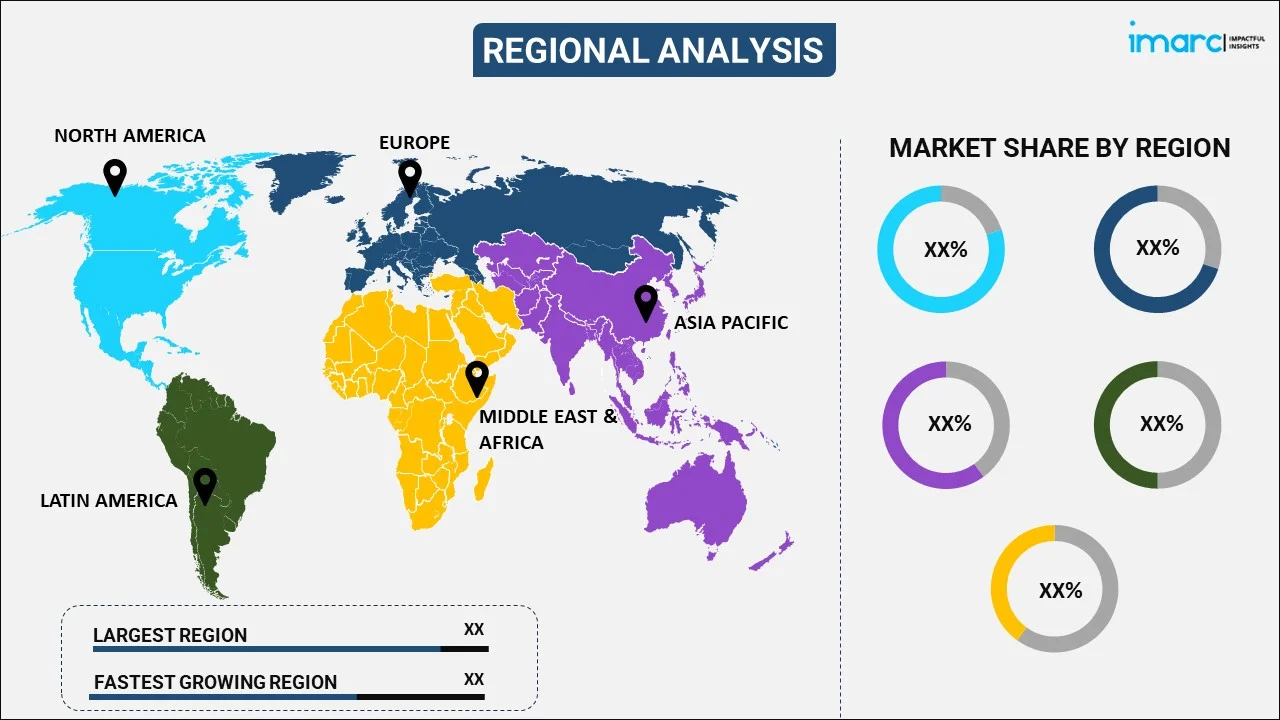
Collaborative Robot Market Report by Component (Hardware, Software), Payload (Upto 5 Kg, 5-10 Kg, Above 10 Kg), Application (Material Handling, Pick and Place, Assembly, Palletizing and De-Palletizing, and Others), End Use Industry (Automotive, Electronics, Manufacturing, Food and Beverage, Chemicals and Pharmaceutical, and Others), and Region 2025-2033
Global Collaborative Robot Market:
The global collaborative robot market size reached USD 3.7 Billion in 2024. Looking forward, the market is expected to reach USD 60.3 Billion by 2033, exhibiting a growth rate (CAGR) of 36.47% during 2025-2033. The rising automation in various industries, advancements in robotics technology, and shortage of labor are primarily driving the market growth.
|
Report Attribute
|
Key Statistics
|
|---|---|
|
Base Year
|
2024
|
|
Forecast Years
|
2025-2033
|
|
Historical Years
|
2019-2024
|
| Market Size in 2024 | USD 3.7 Billion |
| Market Forecast in 2033 | USD 60.3 Billion |
| Market Growth Rate 2025-2033 | 36.47% |
Collaborative Robot Market Analysis:
- Major Market Drivers: The rising need in the logistics industry for handling complicated work processes and several tasks in combination is one of the key factors propelling the market. In addition, the increasing integration of torque and force-sensing technologies in robots is proliferating the overall market.
- Key Market Trends: The rising employment of collaborative robots for manufacturing purposes, such as on assembly lines and welding, is acting as another significant growth-inducing factor. Apart from this, the escalating demand for user-friendly robots, which do not require a highly skilled workforce to carry out operations, is also stimulating the growth of the market.
- Competitive Landscape: Some of the prominent companies in the global market include ABB Ltd., AUBO (Beijing) Robotics Technology Co. Ltd., DENSO WAVE Incorporated (Denso Corporation), Doosan Robotics Inc. (Doosan Group), Fanuc Corporation, Kawasaki Heavy Industries Ltd., KUKA AG (Midea Group), Omron Corporation, Precise Automation Inc. (Brooks Automation Inc), Rethink Robotics GmbH, TechMan Robot Inc. (Quanta Storage Inc.), Universal Robots (Teradyne Inc), and Yaskawa Electric Corporation, among many others.
- Geographical Trends: Advanced manufacturing processes and the widespread adoption of automation technologies are augmenting the market in North America. Moreover, Europe has well-established automotive and manufacturing sectors, which is contributing to the market. Besides this, the growing levels of industrialization and favorable Industry 4.0 initiatives are further bolstering the market in Asia Pacific.
- Challenges and Opportunities: One of the main challenges hindering the market is the elevating concerns regarding ensuring safety while maintaining efficiency. However, the development of sensor technologies to enable seamless human-robot interaction will continue to fuel the market in the coming years.

Collaborative Robot Market Trends:
Demand in E-Commerce and Logistics
Consumers are opting for the convenience of online shopping, driven by factors, such as broader product selection, competitive pricing, the ability to shop anytime from anywhere, etc., which is stimulating the market. For instance, according to a survey by Statista, 20,000 individuals were asked why they chose to shop online in 2021. The convenience of shopping at any time of day was cited as the main justification by 56% of respondents. However, nearly 50% of the global consumers polled stated that they prefer shopping online since it is more convenient than visiting a physical store. As a result, collaborative robots are gaining extensive traction, as they can automate repetitive tasks, such as picking, packing, sorting, palletizing, etc., in warehouses and distribution centers, thereby speeding up processes and reducing errors. For instance, in February 2024, OMRON Automation launched TM S Series Collaborative Robots in India to improve factory productivity in shared workspaces. With greater speed and performance, cobots can execute a variety of activities, including machine tending, assembling, and packaging. These factors are further contributing to the collaborative robot market share.
Automation in Industrial Processes
The rising demand for automation in industrial processes is one of the key factors augmenting the market. Collaborative robots can handle these tasks alongside human workers, thereby allowing for increased production output and reduced cycle times. For instance, according to an article published by Process Solutions, industrial robots can accomplish tasks with precision and repeatability, requiring no stoppages or pauses. Robots' capacity to perform continuously without weariness makes them extremely productive and can result in a speedy return on investment for manufacturers. Robot precision also means fewer errors in the manufacturing process, which often results in less waste and lower production costs. Besides this, in industrial environments, safety is critical. Collaborative robots are designed to operate safely alongside humans, with features, such as sensors and software that enable safe interaction without the need for physical barriers. For instance, in October 2023, Schneider Electric, one of the digital transformation energy management and automation providers, introduced the Lexium Cobot, which is a collaborative machine that incorporates next-generation automation and advanced industrial robotics technology to boost industrial productivity and safety, which is contributing to the global collaborative robot market share.
Technological Advancements
The increasing demand for modern cobots that are equipped with advanced sensors, such as vision systems, is catalyzing the market. These sensors enable cobots to perceive their environment with greater accuracy and sensitivity, thereby allowing them to perform tasks that require intricate manipulation, object recognition, and interaction with humans safely. For instance, in March 2024, Bota Systems AG launched the SenseONE T5, a highly sensitive version of its SensONE multi-axis force-torque sensor. This sensor has a sensitivity level of 0.05 N / 0.002 Nm, which is three to five times higher than its predecessor. It opens new possibilities for collaborative small-payload robots that perform highly sensitive applications. Besides this, AI and machine learning algorithms are increasingly being integrated into cobots to enhance their decision-making capabilities, path planning, and autonomy. This allows cobots to learn from experience, optimize their movements, and adapt to changing conditions or tasks without explicit programming. For instance, in March 2024, Teradyne Robotics partnered with Nvidia to add AI capabilities to industrial robots. Nvidia's computing capacity can accelerate the path-planning process for cobots by up to 50 to 80 times.
Global Collaborative Robot Industry Segmentation:
IMARC Group provides an analysis of the key trends in each segment of the global market report, along with the collaborative robot market forecasts at the global, regional, and country levels from 2025-2033. Our report has categorized the market based on component, payload, application, and end use industry.
Breakup by Component:

- Hardware
- Software
The report has provided a detailed breakup and analysis of the market based on the component. This includes hardware and software.
The demand for hardware is driven by the growing need for cobots with lightweight and compact robotic arms that can perform intricate tasks while occupying minimal space on the factory floor. Software that enables precise motion control, smooth trajectory planning, and efficient path optimization is also crucial. Industries seek cobots capable of executing tasks with high accuracy and minimal cycle times.
Breakup by Payload:
- Upto 5 Kg
- 5-10 Kg
- Above 10 Kg
The report has provided a detailed breakup and analysis of the market based on the payload. This includes upto 5 kg, 5-10 kg, and above 10 kg.
According to the collaborative robot market overview, the up to 5kg segment is often favored in industries requiring delicate handling and precision, such as electronics and pharmaceuticals, where lightweight robots can efficiently perform intricate tasks. The 5-10kg segment serves a broader range of applications, including assembly and material handling, balancing the need for moderate payload capacity with versatility. Robots with a payload capacity above 10kg are increasingly in demand in heavy-duty applications, such as automotive and aerospace industries, where robust performance and the ability to handle substantial loads are critical. This detailed segmentation helps in understanding the diverse requirements and growth potential across different industry verticals.
Breakup by Application:
- Material Handling
- Pick and Place
- Assembly
- Palletizing and De-Palletizing
- Others
The report has provided a detailed breakup and analysis of the market based on the application. This includes material handling, pick and place, assembly, palletizing and de-palletizing, and others.
The need for efficient transportation and organization of goods within warehouses and manufacturing plants drives material handling. The pick and place are crucial in sectors requiring precision and speed, such as electronics and consumer goods. Assembly applications benefit from the robots' ability to enhance productivity and consistency in manufacturing processes. Palletizing and de-palletizing are essential for logistics and supply chain operations, where collaborative robots improve the efficiency of loading and unloading tasks. Additionally, other applications, including quality inspection and machine tending, highlight the versatility and expanding role of collaborative robots in various industries. This detailed analysis helps to identify the specific contributions and growth opportunities within each application segment.
Breakup by End Use Industry:
- Automotive
- Electronics
- Manufacturing
- Food and Beverage
- Chemicals and Pharmaceutical
- Others
The report has provided a detailed breakup and analysis of the market based on the end use industry. This includes automotive, electronics, manufacturing, food and beverage, chemicals and pharmaceutical, and others.
Collaborative robots, or cobots, are increasingly integrated into various industries to streamline operations, improve productivity, ensure quality, and enhance worker safety. In the automotive industry, they assist in assembling components such as dashboard modules, seats, and engines. They perform tasks like screwing, riveting, and gluing with precision. While in the electronics industry, collaborative robots assist in PCB assembly by placing electronic components precisely onto circuit boards, optimizing SMT processes. Apart from this, in the manufacturing industry, they pick components from bins or conveyors and place them in assembly processes, optimizing workflow and reducing cycle times.
Breakup by Region:

- North America
- United States
- Canada
- Asia-Pacific
- China
- Japan
- India
- South Korea
- Australia
- Indonesia
- Others
- Europe
- Germany
- France
- United Kingdom
- Italy
- Spain
- Russia
- Others
- Latin America
- Brazil
- Mexico
- Others
- Middle East and Africa
The report has also provided a comprehensive analysis of all the major regional markets, which include North America (the United States and Canada); Asia Pacific (China, Japan, India, South Korea, Australia, Indonesia, and others); Europe (Germany, France, the United Kingdom, Italy, Spain, Russia, and others); Latin America (Brazil, Mexico, and others); and the Middle East and Africa.
North America is one of the prominent markets for cobots, driven by the adoption of industrial automation and technological advancements. Moreover, in Europe, cobots are widely used in automotive assembly, inspection, and material handling. Besides this, Asia-Pacific is the fastest-growing region for cobots, fueled by rapid industrialization, the expanding manufacturing sectors, and the increasing labor costs. Also, in this region, collaborative robots are employed across diverse industries for assembly, material handling, and machine tending.
Competitive Landscape:
The market research report has provided a comprehensive analysis of the competitive landscape. Detailed profiles of all major market companies have also been provided. Some of the key players in the market include:
- ABB Ltd.
- AUBO (Beijing) Robotics Technology Co. Ltd.
- DENSO WAVE Incorporated (Denso Corporation)
- Doosan Robotics Inc. (Doosan Group)
- Fanuc Corporation
- Kawasaki Heavy Industries Ltd.
- KUKA AG (Midea Group)
- Omron Corporation
- Precise Automation Inc. (Brooks Automation Inc.)
- Rethink Robotics GmbH
- TechMan Robot Inc. (Quanta Storage Inc.)
- Universal Robots (Teradyne Inc.)
- Yaskawa Electric Corporation
(Please note that this is only a partial list of the key players, and the complete list is provided in the report.)
Collaborative Robot Market Recent Developments:
- June 2024: Delta introduced six variants in its six-axis D-Bot series of collaborative industrial robots for precision in pick and place, welding, and pelletizing applications.
- May 2024: Kassow Robots launched the world’s first 7-axis cobots in which the controller is integrated into the base of the robot.
- May 2024: IPG Photonics Corporation, one of the fiber laser solutions providers, developed an automated cobot laser welding and cleaning system for fabrication and manufacturing industries.
Collaborative Robot Market Report Scope:
| Report Features | Details |
|---|---|
| Base Year of the Analysis | 2024 |
| Historical Period | 2019-2024 |
| Forecast Period | 2025-2033 |
| Units | Billion USD |
| Scope of the Report | Exploration of Historical Trends and Market Outlook, Industry Catalysts and Challenges, Segment-Wise Historical and Predictive Market Assessment:
|
| Components Covered | Hardware, Software |
| Payloads Covered | Upto 5 Kg, 5-10 Kg, Above 10 Kg |
| Applications Covered | Material Handling, Pick and Place, Assembly, Palletizing and De-Palletizing, Others |
| End Use Industries Covered | Automotive, Electronics, Manufacturing, Food and Beverage, Chemicals and Pharmaceutical, Others |
| Regions Covered | Asia Pacific, Europe, North America, Latin America, Middle East and Africa |
| Countries Covered | United States, Canada, Germany, France, United Kingdom, Italy, Spain, Russia, China, Japan, India, South Korea, Australia, Indonesia, Brazil, Mexico |
| Companies Covered | ABB Ltd., AUBO (Beijing) Robotics Technology Co. Ltd., DENSO WAVE Incorporated (Denso Corporation), Doosan Robotics Inc. (Doosan Group), Fanuc Corporation, Kawasaki Heavy Industries Ltd., KUKA AG (Midea Group), Omron Corporation, Precise Automation Inc. (Brooks Automation Inc), Rethink Robotics GmbH, TechMan Robot Inc. (Quanta Storage Inc.), Universal Robots (Teradyne Inc), Yaskawa Electric Corporation, etc. |
| Customization Scope | 10% Free Customization |
| Post-Sale Analyst Support | 10-12 Weeks |
| Delivery Format | PDF and Excel through Email (We can also provide the editable version of the report in PPT/Word format on special request) |
Key Benefits for Stakeholders:
- IMARC’s industry report offers a comprehensive quantitative analysis of various market segments, historical and current market trends, market forecasts, and dynamics of the collaborative robot market from 2019-2033.
- The research report provides the latest information on the market drivers, challenges, and opportunities in the global collaborative robot market.
- The study maps the leading, as well as the fastest-growing, regional markets. It further enables stakeholders to identify the key country-level markets within each region.
- Porter's five forces analysis assists stakeholders in assessing the impact of new entrants, competitive rivalry, supplier power, buyer power, and the threat of substitution. It helps stakeholders to analyze the level of competition within the collaborative robot industry and its attractiveness.
- The competitive landscape allows stakeholders to understand their competitive environment and provides insight into the current positions of key players in the market.
Key Questions Answered in This Report
The collaborative robot market was valued at USD 3.7 Billion in 2024.
The collaborative robot market is projected to exhibit a CAGR of 36.47% during 2025-2033.
The collaborative robot (cobot) market is driven by advancements in automation, increasing demand for flexible manufacturing solutions, and cost reduction in industrial processes. Cobots' ability to work alongside humans, enhancing safety and productivity, coupled with the growth of small and medium-sized enterprises (SMEs) adopting automation, further fuels market growth.
Asia Pacific currently dominates the market driven by rapid industrialization, technological advancements, and increasing labor costs.
Some of the major players in the collaborative robot market include ABB Ltd., AUBO (Beijing) Robotics Technology Co. Ltd., DENSO WAVE Incorporated (Denso Corporation), Doosan Robotics Inc. (Doosan Group), Fanuc Corporation, Kawasaki Heavy Industries Ltd., KUKA AG (Midea Group), Omron Corporation, Precise Automation Inc. (Brooks Automation Inc.), Rethink Robotics GmbH, TechMan Robot Inc. (Quanta Storage Inc.), Universal Robots (Teradyne Inc.), and Yaskawa Electric Corporation, etc.
Need more help?
- Speak to our experienced analysts for insights on the current market scenarios.
- Include additional segments and countries to customize the report as per your requirement.
- Gain an unparalleled competitive advantage in your domain by understanding how to utilize the report and positively impacting your operations and revenue.
- For further assistance, please connect with our analysts.
 Request Customization
Request Customization
 Speak to an Analyst
Speak to an Analyst
 Request Brochure
Request Brochure
 Inquire Before Buying
Inquire Before Buying




.webp)




.webp)












